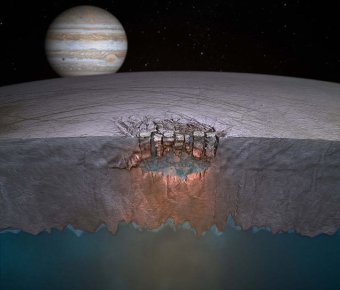At the beginning of the 17th century, few people contributed to the invention of the refracting telescope. It was the beginning of lenses capable of observing objects with a large aperture. In 1610, Galileo Galilei provided the major contribution to the design of this optical device and used it in order to observe celestial bodies. Among other observations and discoveries, he pointed the refracting telescope at the giant planet Jupiter. It was such a surprise when he discovered that Earth was not the only planet with a moon. Actually, at this time Galileo observed four of the natural satellites around Jupiter: Io, Europa, Ganymede and Callisto.
In 1996, Galileo the space probe made the most significant discovery since Galileo the scientist: Europa has water ice on the surface with a higher mineral content which may allow extraterrestrial life! In 1982, in his book 2010: Odyssey Two, Arthur C. Clarke imagined an ocean below Europa’s ice which hosted a form of life.
Europa is the sixth-closest natural satellite of Jupiter. It orbits the giant planet in three and half Earth days and is slightly smaller than the Moon. From Earth, spectroscopy helps to determine the composition of planets. The light from Europa was observed with different wavelengths which revealed that the planet was composed of silicate rock and has an iron core. The layer of water ice wasn’t detected until the space probe Galileo flew over Europa in 1996. A salty ocean covered the entire planet below the water ice layer. This demonstrates the need of space exploration: Observing and discovering features which are not possible to do remotely.
Conditions of life on Europa
This satellite of Jupiter harbors the conditions necessary for life such as liquid water, appropriate chemical elements and energy. These are essential elements for the presence of life in the form as we know it; carbon based.
By studying the Jovian magnetic field and its surface, Europa allowed us to discover some of its mysteries. It appears that the surface has been transformed by tectonic activity. Planetary scientists found evidence of presence of salty liquid water below the ice water surface.
Jupiter constantly bombards Europa with radiation. Europa’s surface is composed of water ice and other material which is transformed into oxygen, hydrogen peroxide, carbon dioxide and sulfur dioxide. These components could be valuable nutrients for supporting life.
In order to have water in liquid form, the planet must receive appropriate heat. This may be generated with the interaction of Jupiter’s gravity and its others moons Io and Ganymede. On Earth, we experience the same interaction with the Moon over oceans but regarding Jupiter’s gravity it is microscopic.
On Earth, early life appeared in deep oceans where light doesn’t exist. This means that not all life is dependent on photosynthesis.
All these elements indicate that a form of life has great chance to exist on Europa below the surface. Compared to Mars where the presence of liquid water hasn’t been proven yet, Europa seems more likely to host life.
Around 2022 the European Space Agency (ESA) plans to launch the space probe “Jupiter Icy Moon Explorer” (JUICE) which will explore Jupiter, Calisto, Europe and Ganymede. Regarding Europa, JUICE will look for evidence of the ocean and determine the composition of the ice. There are large expectations from this mission to provide components that could support the presence of alien life on Europa.
Because we are all Born For Space!


